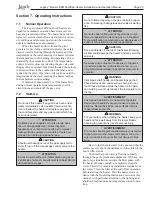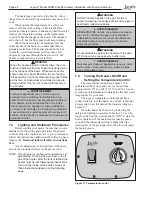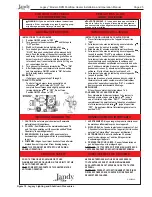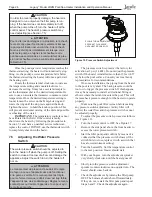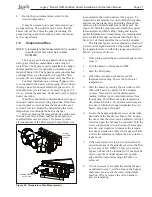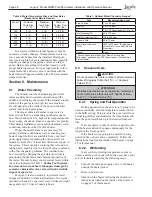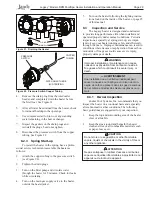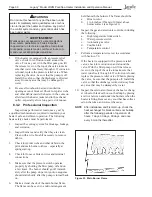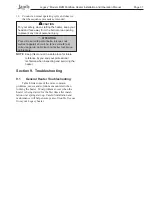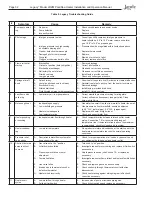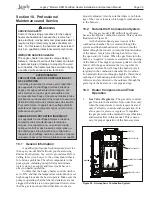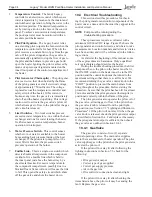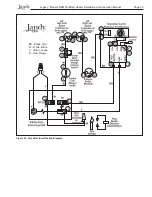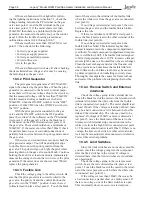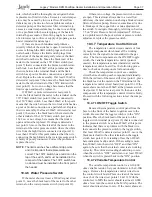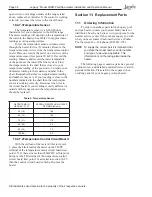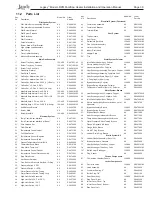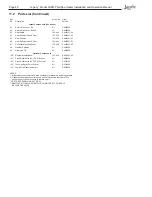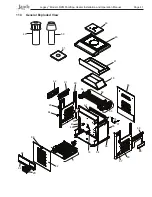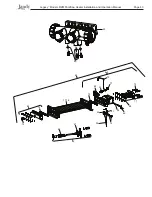
Page 37
Legacy
™
Model LRZM Pool/Spa Heater Installation and Operation Manual
ture, which should be thoroughly investigated before
replacement of limit switches. Excessive water temper-
ature may be caused by low water
fl
ow. Water
fl
ow
de
fi
ciency may be due to obvious problems such as a
defective pump or blocked water
fi
lter. Alternatively,
excessive water temperature may be due to over-
fi
ring,
or to a problem with the water piping or the heater's
internal bypass control. Over-
fi
ring might be a result
of an incorrect gas ori
fi
ce or supply of propane gas to a
heater intended for natural gas.
If there are no such fundamental problems,
identify which of the switches is open. Limit switch
access is through the limit switch plugs on the inlet/
outlet header. Remove the limit switch plugs from
the bottom of the header and gently remove the limit
switches from the wells. Move the black lead of the
meter to the terminal on the 150°F limit switch (test
point 7) that is connected to the
fi
reman switch termi-
nal block. Less than 220mV at this point means that
the wire between the terminal block and the limit
switch has a poor or broken connection or a partial
short. Replace the wire assembly. If at least 220mV is
detected at test point 7, then move the black lead of the
meter to the other terminal of the 150°F limit switch
(test point 8). Low or no voltage here means that the
limit is open and must be replaced.
If 220mV or more is detected at test point 8,
move the black lead of the meter to the terminal on the
130°F limit switch (test point 9) that is connected to
the 150°F limit switch. Less than 220mV at this point
means that the wire between the two limit switches has
a poor or broken connection or a partial short. Replace
the wire assembly. If at least 220mV is detected at test
point 9, then move the black lead of the meter to the
other terminal of the 130°F limit switch (test point
10). Low or no voltage here means that the limit is
open and must be replaced. If voltage is detected at
test point 10, move the black lead of the meter to the
terminal of the water pressure switch where the white
wire from the high limits is connected (test point 11).
Less than 220mV at this point indicates that the wire
connecting the high limits to the water pressure switch
is faulty or poorly connected. Correct the problem or
replace the wire.
NOTE
The limit switches have different trip points,
and it is important that replacements are
correct. The 150°F switch has a red dot on the
top of the switch, and must be installed in the
rear port of the header. The 130°F switch has
no dot and must be installed in the front port of
the header.
10.4.6 Water Pressure Switch
If the meter shows at least a 220mV signal at test
point 11, move the black lead of the meter to the other
terminal on the water pressure switch (test point 12).
If there is no voltage, the pressure switch contacts
are open. This is almost always due to a water
fl
ow
de
fi
ciency, the most common one being a blocked water
fi
lter or defective pump. However, sometimes it is due
to blockage of the copper tube or mis-adjustment of
the switch. Investigate thoroughly, referring to Section
7.5 on “Water Pressure Switch Adjustment”. If there
is no problem with the pool system or pressure switch
adjustment, replace the pressure switch.
10.4.7 Temperature Control Circuit
The temperature control circuit consists of four
(4) major components which must all be working
correctly for the signal to be transmitted to the gas
valve. The four components are the ON/OFF toggle
switch, the variable temperature control (potenti-
ometer), the temperature sensor (thermistor) and the
temperature control board. Use the following proce-
dure to check each component for functionality.
Check the temperature control as a complete
circuit before checking each component individually.
With the red lead of the meter still at test point 1, place
the black lead of the meter on the TH terminal of the
temperature control circuit board (test point 16). If the
meter shows more than 220mV at the pressure switch
(test point 12) but not at test point 16, then one of the
components of the temperature control circuit is faulty.
Proceed with the following sections to test the compo-
nents.
10.4.7.1 ON/OFF Toggle Switch
Remove the temperature control panel from the
bezel on the front of the heater to gain access to the
switch. Be sure that the toggle switch is in the "ON"
position. Place the black lead of the meter on the
toggle switch terminal (test point 13) that is connected
to the pressure switch. Less than 220mV at this point
indicates that there is a problem with the black wire
that connects the pressure switch to the toggle switch.
If at least 220mV is detected at test point 13, move the
black meter lead to the other terminal on the toggle
switch (test point 14). A reading of less than 220mV
here indicates a faulty switch. If the reading is more
than 500mV, turn the switch "OFF" and then "ON"
again to be sure that the internal contacts are working
correctly. The volt meter reading should drop to zero
when the switch is "OFF" and return to at least 220mV
when the switch is placed back in the "ON" position.
10.4.7.2 Variable Temperature Control
The variable temperature control is a 0-10,000
ohm variable resistor. Set your ohmmeter to the 0-20K
range. Remove the temperature control wires from
the control circuit board. Place one lead of the meter
on each of the wires (test points 18 & 19). With the
control set to MIN the meter should read near 10,000
ohms. Now turn the control to the MAX position. The
meter should read close to zero. If the meter shows an
Summary of Contents for Legacy LRZM
Page 2: ......

